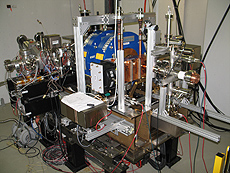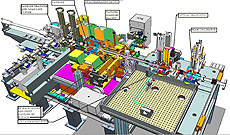Preparing to provide NML's electron beam in 2013
 |
Fermilab AD employees recently completed the assembly of the electron gun in NML. Photo: Jerry Leibfritz, AD |
NML is a warehouse abuzz with humming electrical racks, hundreds of circuit boards and an enclosed laser room, which requires special training to enter. At the center of it all is the electron gun, which, if all goes well, will fire its first electron beam early next year.
Providing electron beam is an essential part of the laboratory's advanced accelerator R&D program, which includes testing superconducting radio-frequency cryomodules. The cryomodules are a key component of Project X, one of the laboratory's principal proposed projects. They will provide powerful electromagnetic fields that accelerate particle beams. To ensure the technology of these cryomodules is as efficient as possible, scientists will soon begin testing them using the laboratory's new electron gun.
The gun itself is a meter-long copper tube, but the many adjoining components that help shape the beam and accelerate electrons make the entire apparatus about the size of a smart car. At one end of the gun is the gun cavity, which houses a cesium telluride-coated cathode—the electron source.
To generate free electrons inside the gun cavity, scientists will shine a powerful, ultraviolet laser onto the cathode. A high electric field then pulls the electrons away from the cathode surface and accelerates them toward the exit. Solenoid magnets outside the cavity produce a magnetic field inside, which focuses the electrons and prevents them from drifting away.
Ding Sun, the expert that ensures the gun cavity works properly, has his work cut out for him.
"The cavity is the heart of the gun," Sun said. "The diameters of the two cells of the cavity must be 180.18 and 180.84 millimeters respectively, and to within .01 millimeters, or the gun won't work. Accuracy is essential."
An electron beam's intensity, or electron density, is contingent upon the frequency of the laser. The faster the laser's pulse, the more electrons the gun can fire in a certain amount of time. Compared to the electron gun at AZero, NML's gun will run at higher laser frequencies, higher electric field and longer pulses, producing beams with about 10 percent more energy, between 4.5 and 5 MeV.
A proposal has been submitted for the Advanced Superconducting Test Accelerator, which would be capable of producing beam of various energies for a number of experiments. If approved, ASTA would eventually become a user facility where scientists from organizations across the country can use the electron beam to test the technology and optics, for example, of their own apparatuses.
Richard Andrews, the gun's principal mechanical engineer, has been with the project since it started in 2007 and is impressed at how the team has grown from just a handful of employees to several dozen across many departments.
"How a project of this complexity can evolve to create a beautiful functioning machine to help us go forward is a tribute to the lab's extensive talents," Andrews said.
—Jessica Orwig
 |
A 3-D model cross section of the electron gun apparatus. Image: Tim Hamerla, AD |
|